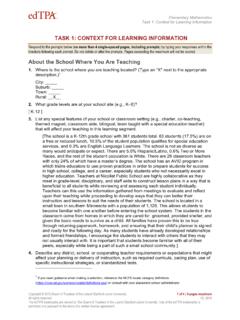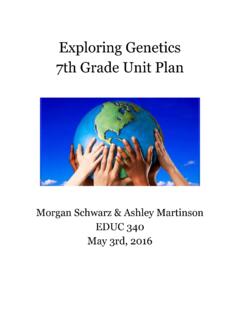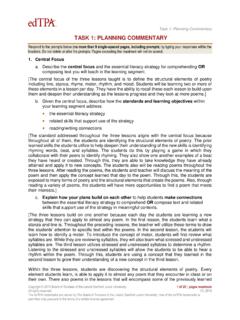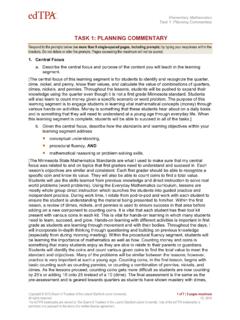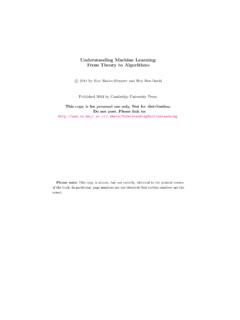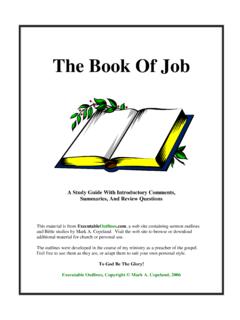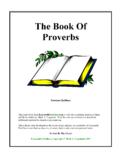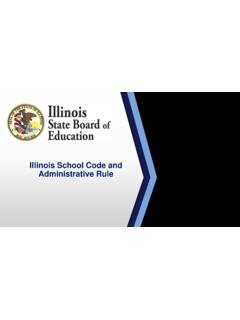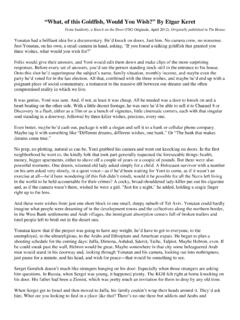Transcription of The Holocaust Unit Plan 8th Grade - Bethany Lutheran College
1 The Holocaust unit plan 8th Grade Morgan Schwarz, Ashley Martinson, Rachael Heidorn 1 Names: Morgan Schwarz, Ashley Martinson, Rachael Heidorn unit Topic/Theme: The Holocaust Focused Grade Level: 8th Grade Introduction to unit Introduction: The Holocaust refers to a specific genocidal event in twentieth-century history: the state-sponsored, systematic persecution and anni- hilation of European Jewry by Nazi Germany and its collaborator between 1933 and 1945. Jews were the primary victims- 6 million were murdered Gypsies, the handicapped, and Poles were also targeted for destruction or decimation for racial, ethnic, or national reasons. Millions more, including homosexuals, Jehovah s Witnesses, Soviet prisoners of war, and political dissidents, also suffered grievous oppression and death under Nazi tyranny. unit Goals/Objectives Summarized: Students will raise and consider key questions regarding the Holocaust .
2 Students will realize that man s inhumanity to man can sur-face in a variety of historical circumstances. Students will recognize that racial slurs and ethnic jokes are stepping-stones on a long road, which in the end may end to genocide. Students will understand that prejudice has had a long history and is still alive today. Standards Addressed: Exhibit civic skills, including participating in civic discussion on issues in the contemporary world, demonstrating respect for the opinions of people or groups who have different perspectives, and reaching consensus. ( ) Pose questions about a topic in world history; gather and organize a variety of primary and secondary sources related to the questions; analyze sources for credibility and bias; suggest possible answers and write a thesis statement; use sources to draw conclusions and support the thesis; and present supported findings and cite sources.
3 ( ) 2 Review of WWI (Economics) Objectives: Cognitive: At the completion of this lesson, learners will be able to recall Germany s reparations. Cognitive/Affective: During this lesson, learners will be able to recall and decipher the causes of the Holocaust , given the appropriate instruction. Materials: Notebook Paper WWI Website Vocabulary: WWI Stalemate Treaty of Versailles Procedure: are to go to this website. need to pick out 10 important facts that may have led to the start of WWII student will read their answers and the teacher will compile them on a Smartboard notebook page. teacher should not write down any repeats. student should not say any repeats. Assessment: The students will turn in their 10 facts for grading. 3 Diary of Anne Frank (The Play) (Children s Literature and History) Objectives: Psychomotor: During the lesson, students will read aloud in class, given appropriate public speaking guidelines.
4 Psychomotor: During the lesson, students will access The Secret Annex tour online, given the appropriate information and guidelines. Materials: Play Secret Annex Website Computer Access Notebook Paper Vocabulary: Annex: a building joined to or associated with a main building, providing additional space or accommodations. Procedure: off by having the students flip through the play. them what they think they will read, if anyone has read it before, and any questions they might have about what they see. through the play. Everyone should read with dramatic voices and voice change for punctuation. the students are reading, have them jot down anything they might be wondering. Assessment: The students will get to see first hand what they read about by going through each room of the annex. The students will answer the following questions (on attached worksheet) while they explore the website.
5 4 Name _____ Date _____ The Holocaust : Self Perceptions 1) What would you do to keep yourself busy in such a tight space? _____ 2) Would you be okay living with so many people? Why or why not? _____ 3) How do you think they kept so quiet for so long? _____ 4) Do you think they were tempted to leave at any time? Why or why not? _____ 5) What do you think would have happened if they were never caught? _____ 5 The Nazi Party (History/Government) Objectives: Cognitive: Students will be able to define the characteristics of the beginning of the Nazi Party. Affective: Students will be able to infer the danger the Nazi Party imposed on Jews. Psychomotor: Students will record important information regarding the Nazi Party. Materials: Powerpoint Vocabulary: Embedded within slides (words and definitions) Procedure: direct instruction lesson from the powerpoint. students to record important information in Cornell Notes.
6 Assessment: The students may copy this template in their notebooks and hand it in. The teacher may also provide a copy to the students to save time, if needed. 6 Jewish Culture (Sociology/Religion) Objectives: Cognitive: Students will be able to describe Jewish religion. Affective: Students will be able to compare Jewish customs to Christian customs. Psychomotor: Students will eat food that Jews eat. Materials: Celebrate: A Book of Jewish Holidays by Judy Gross Vocabulary: Names of Jewish holidays that are defined in the book Procedure: the book with students. discussion about how Jewish holidays and culture fit into the norm American holidays and culture a Venn Diagram comparing and contrasting Jewish customs to Christian Customs students snack on apples dipped in honey (symbolizing Jews eat during Rosh Hashanah) Formative Assessment: Students will have copied the Venn diagram and participated in discussion.
7 7 Using a Map (Geography) Objectives: Cognitive: Students will be able to locate and describe the location of countries involved in WWII and the Holocaust . Affective: Students will be able to describe the effect of geography on WWII and the Holocaust . Psychomotor: Students will be able to label countries on a map of their own. Materials: A map of Europe and Russia and/or a globe Vocabulary: Copenhagen Sweden Germany Poland Norway Finland Russia North Sea Baltic Sea Procedure: a map/globe. students to locate the above terms/locations on a map where the Allies and Axis powers are in Europe. the impact of geography on Copenhagen and its citizens how geography helped Ellen and her family get to safety. Formative Assessment: Have students label the map below and color it to show where the Allies and Axis powers were. They will create a key in the bottom right corner. 8 9 10 Nutrition (Concentration Camps vs.)
8 You) (Health/Science) Objectives: Psychomotor: During the lesson, students will be able to research the diets of those in concentration camps. Psychomotor: During the lesson, student will be able to accurately maintain a daily log of the calories that they take in. Affective: At the completion of this lesson, students will be able to compare their caloric intake with those in the concentration camps. Materials: Websites Vocabulary: calories Procedure: students access the first website given above them to write down what people in concentration camps for each meal. Have them also add and record the total number of calories they would take in during a day. have students access the second website given above students to write down healthy foods and a healthy caloric intake for a person their age. student compare and contrast the foods they eat with those eaten by people in the concentration camps.
9 Assessment: Have students keep a food journal for 3 days. Then help them average their caloric intake for those 3 days and once again compare it with the data given about those in concentration camps. 11 Number the Stars (Children s Literature) Cognitive/Psychomotor: During the lesson, students will read the text as class or individually and be able to recall specific events and characters as prompted. Psychomotor: During the lesson, students will be able to participate in discussions about themes within the book and distinguish between different scenarios. Psychomotor: At the completion of the lesson, students will be able to create a book report corresponding to the book. Materials: Number the Stars Book Discussion Questions Worksheet Vocabulary: resistance Swastika synagogue defiantly distorted Star of David rabbi hebrew Procedure: the first chapter to the student.
10 One chapter per day. out the discussion questions worksheet on the first day. Have them fill it out as they read. Assessment: The discussion questions should be fully completed. 12 Cause and Effect Timeline (Economics/Government/Civics/Sociology/G eography/Anthropology) Cognitive: During the lesson, students will be able to accurately recall major events from the Holocaust . Affective: At the completion of the lesson, students will be able to identify the causes and effects of these events from the Holocaust . Psychomotor: Given the appropriate events, by the end of the lesson, students will be able to place events in chronological order. Materials: Years Timeline Cards Victim ID Cards WWII and Holocaust Cards Laws and Decrees Cards US and World Response Cards Vocabulary: victim persecution decrees Procedure: I: Years: Prior to beginning the lesson with students, place the timeline cards of each year around the classroom, preferably stretched out horizontally.
